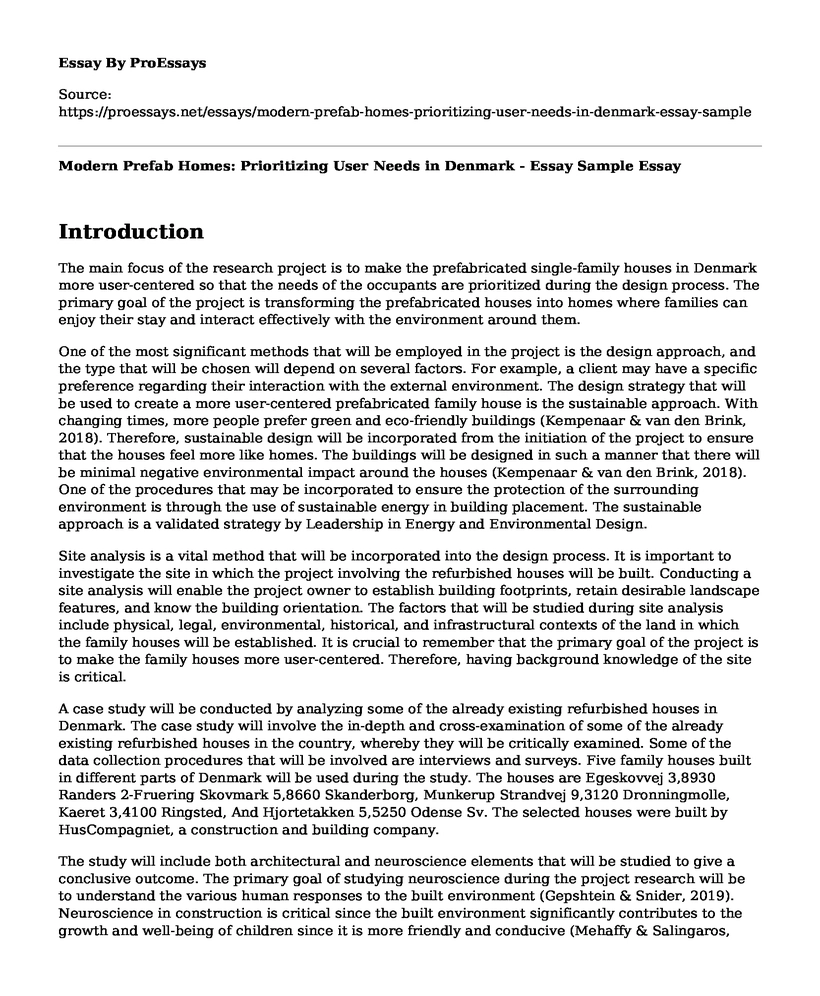Introduction
The main focus of the research project is to make the prefabricated single-family houses in Denmark more user-centered so that the needs of the occupants are prioritized during the design process. The primary goal of the project is transforming the prefabricated houses into homes where families can enjoy their stay and interact effectively with the environment around them.
One of the most significant methods that will be employed in the project is the design approach, and the type that will be chosen will depend on several factors. For example, a client may have a specific preference regarding their interaction with the external environment. The design strategy that will be used to create a more user-centered prefabricated family house is the sustainable approach. With changing times, more people prefer green and eco-friendly buildings (Kempenaar & van den Brink, 2018). Therefore, sustainable design will be incorporated from the initiation of the project to ensure that the houses feel more like homes. The buildings will be designed in such a manner that there will be minimal negative environmental impact around the houses (Kempenaar & van den Brink, 2018). One of the procedures that may be incorporated to ensure the protection of the surrounding environment is through the use of sustainable energy in building placement. The sustainable approach is a validated strategy by Leadership in Energy and Environmental Design.
Site analysis is a vital method that will be incorporated into the design process. It is important to investigate the site in which the project involving the refurbished houses will be built. Conducting a site analysis will enable the project owner to establish building footprints, retain desirable landscape features, and know the building orientation. The factors that will be studied during site analysis include physical, legal, environmental, historical, and infrastructural contexts of the land in which the family houses will be established. It is crucial to remember that the primary goal of the project is to make the family houses more user-centered. Therefore, having background knowledge of the site is critical.
A case study will be conducted by analyzing some of the already existing refurbished houses in Denmark. The case study will involve the in-depth and cross-examination of some of the already existing refurbished houses in the country, whereby they will be critically examined. Some of the data collection procedures that will be involved are interviews and surveys. Five family houses built in different parts of Denmark will be used during the study. The houses are Egeskovvej 3,8930 Randers 2-Fruering Skovmark 5,8660 Skanderborg, Munkerup Strandvej 9,3120 Dronningmolle, Kaeret 3,4100 Ringsted, And Hjortetakken 5,5250 Odense Sv. The selected houses were built by HusCompagniet, a construction and building company.
The study will include both architectural and neuroscience elements that will be studied to give a conclusive outcome. The primary goal of studying neuroscience during the project research will be to understand the various human responses to the built environment (Gepshtein & Snider, 2019). Neuroscience in construction is critical since the built environment significantly contributes to the growth and well-being of children since it is more friendly and conducive (Mehaffy & Salingaros, 2018). The families that live in the houses that will be investigated will be required to give a brief report on the effect of the built environment on the growth and overall health of their children. Data will then be gathered and analyzed to get a conclusion that will enable the new family houses to be transformed in a better way and accommodate all the requirements the various families need.
Reference List
Gepshtein, S. and Snider, J., 2019. Neuroscience for architecture: The evolving science of perceptual meaning. Proceedings of the National Academy of Sciences, 116(29), pp.14404-14406.
Kempenaar, A. and van den Brink, A., 2018. Regional designing: A strategic design approach in landscape architecture. Design Studies, 54, pp.80-95.
Mehaffy, M.W. and Salingaros, N.A., 2018. The Neuroscience of Architecture: The Good, the Bad-and the Beautiful. Traditional Building Magazine.
Cite this page
Modern Prefab Homes: Prioritizing User Needs in Denmark - Essay Sample. (2023, Mar 25). Retrieved from https://proessays.net/essays/modern-prefab-homes-prioritizing-user-needs-in-denmark-essay-sample
If you are the original author of this essay and no longer wish to have it published on the ProEssays website, please click below to request its removal:
- A Response to the City Lights Film
- Film Analysis Essay on It's a Wonderful Life
- Exploring Hip Hop Music: Beyond Controversies & Social Significance - Essay Sample
- Understanding Historical Themes: Linking Past and Present - Essay Sample
- Essay Sample on Documentary Photography: War, Struggles, & Silence in DRC's North Kivu
- Essay Example on Zappos: Outstanding Customer Service & Data-Driven Performance
- The Political Economy of Digital Platforms - Report Sample







